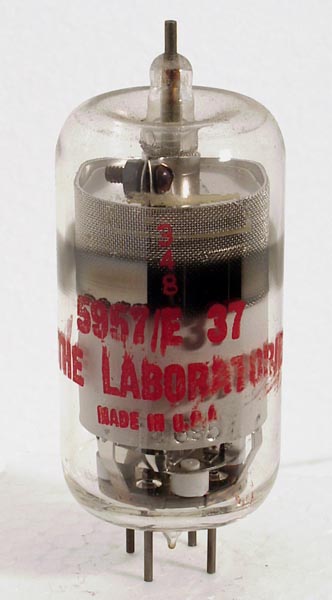
|
The 5957E is a late 1950s hydrogen-filled thyratron.It is most probable that the 0.1A rating refers to average anode current and that the peak current rating would be much higher. Likewise the anode voltage is the peak value and not a constant value.During operation the hydrogen gas in the discharge path is highly ionised and physical movement of this ionised gas contributes to current flow. Essentially, a red-hot gust of gas sweeps through the valve.It is important to confine gas flow to certain paths and to prevent gas from reaching the glass in an ionised state. The mesh 'shield' and the ring of mesh just visible under the anode stem clamp are to ensure that gas in contact with the glass remains de-ionised.X-rays are not normally a problem with hydrogen thyratrons provided the valves are triggered correctly and are fitted with a small inductor attached to the anode cap. If these precautions are not taken an exceedingly brief burst of X-rays is generated each time the thyratron is triggered with more than a few kV across it. More importantly, incorrect initiation of discharge causes sputtering at the electrode surfaces so that the electrodes are gradually eroded and deposited as internal 'silvering' on the glass. This effect is clearly seen in the photo, implying that the specimen has been misused.Larger hydrogen thyratrons, used in radar pulsers, commonly operate at 30 kV pk, hundreds of Amps (peak) and up to 1000 pulses per second. In such cases the X-ray output due to misuse can be significant. For a small thyratron operated at not more than 8kV the X-rays generated would be unlikely to pass through the internal structure and the glass envelope at sufficient strength to constitute a hazard, though it is always wise to carry out a radiological check.The wide glass tube envelope is 36 mm in diameter and, excluding the base pins, is 84 mm tall.Reference: Data-sheet. |
Absolute Maximum Operating Conditions¶
| Vh | Ah | Va | mAa | 
| 6.3 | 6.1 | 8kv | 100 |
|
Updated April 23, 2013.
|
|